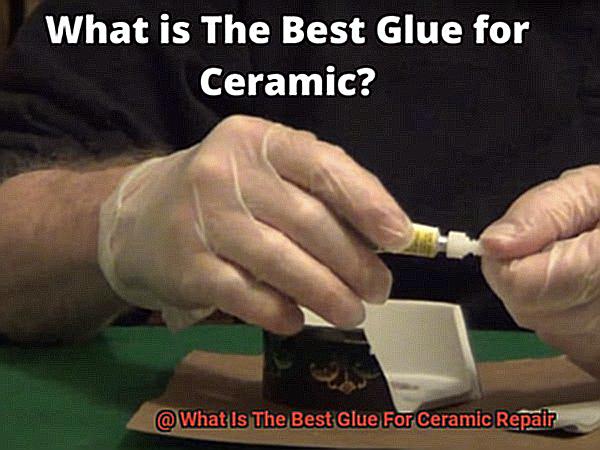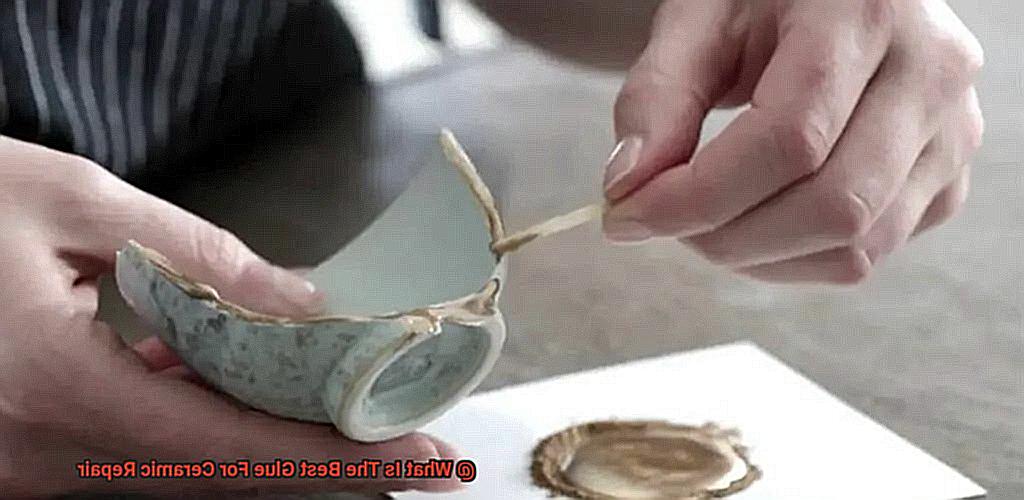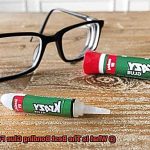Picture this: you’re cradling a cherished ceramic vase, passed down through generations, when suddenly it slips from your grasp and shatters into a dozen delicate pieces. Panic sets in as you frantically wonder how on earth you can mend this beloved treasure. But fear not, dear reader. Today, we embark on an epic quest to discover the best glue for ceramic repair.
Join me as we dive headfirst into the captivating world of pottery restoration, where centuries of craftsmanship collide with modern adhesive wonders. Whether it’s a precious family heirloom, a meticulously handcrafted masterpiece, or your favorite quirky coffee mug, knowing the ideal adhesive for ceramic repair is crucial to restoring these treasures to their former glory.
Intrigued? Well, hold onto your hats because here’s a sneak peek of what awaits:
- The Criteria: Prepare to explore the vital factors that must be considered when hunting for that perfect ceramic glue. We’ll uncover the secrets behind bonding strength and flexibility, as well as the water and heat resistance necessary for a repair that stands the test of time.
- Types of Adhesives: Brace yourself for a deep dive into the diverse realm of ceramic repair glues. From epoxy to cyanoacrylate and even specialized formulas designed specifically for ceramics, each adhesive boasts its own unique characteristics, advantages, and potential drawbacks. Get ready to discover which one suits your needs best.
- Application Tips: Armed with your chosen adhesive, get ready to learn some trade secrets on how to effectively apply glue to those broken ceramic pieces. We’ll guide you through surface preparation techniques and clamping methods with precision so that every step brings you closer to achieving a seamless result.
- Beyond the Repair: Don’t think our journey ends once your ceramic item is restored. Explore the additional factors to consider, such as how the choice of glue can impact the overall aesthetics and durability of your repaired ceramics. We’ll even touch on potential future repairs, because preparation is key.
So whether you’re a seasoned artisan or a curious DIY enthusiast, our quest to find the best glue for ceramic repair promises an exhilarating adventure. Get ready to rescue those shattered ceramic dreams and bring them back to life, one carefully placed drop of adhesive at a time.
What is Ceramic Repair?
Contents
Ceramic items hold a special place in our homes and hearts, with their delicate beauty and functionality. However, accidents happen, and these precious pieces may become chipped or broken. Fear not, for ceramic repair is here to save the day. In this article, we will explore the various techniques and glue options used to restore broken ceramic items to their former glory.
Glue Options for Ceramic Repair:
When it comes to ceramic repair, using the right glue is crucial. Here are some popular options:
- Epoxy Adhesive: Known for its exceptional bonding strength, epoxy adhesive is a top choice for ceramic repair. Its two-component formula – resin and hardener – ensures a strong and durable bond. Epoxy adhesive can withstand high temperatures, moisture, and even chemical exposure. Once cured, it can be sanded or painted over, seamlessly blending with the original ceramic surface.
- Cyanoacrylate (Super Glue): For small repairs or delicate ceramic pieces, cyanoacrylate, commonly known as super glue, is your go-to option. It forms a quick and secure bond. However, keep in mind that super glue may not be as durable as epoxy adhesive and might not hold up well under extreme conditions or frequent use.
- Polyurethane Adhesive: Versatile and strong, polyurethane adhesive is suitable for both porous and non-porous ceramics. Its bonding capabilities make it ideal for various repair projects. Additionally, it offers excellent resistance to water and heat. The flexible nature of polyurethane adhesive makes it ideal for objects that may experience slight movement or stress.
- Silicone Adhesive: If you’re working on ceramic items that come into contact with water, such as bathroom fixtures or kitchen utensils, silicone adhesive is the way to go. It provides a waterproof bond and remains flexible even after curing. However, keep in mind that silicone adhesive may not be as strong as other options and may not be suitable for heavy-duty repairs.
Factors to Consider:
Before choosing the glue for your ceramic repair, consider the specific requirements of your project. Factors such as the size of the repair area, the type of ceramics involved, and the intended use of the repaired item should be taken into account. Reading the manufacturer’s instructions and recommendations is essential to ensure proper application and curing.
Types of Glue Used for Ceramic Repair
When it comes to restoring broken ceramics, the glue you choose can make or break the success of your repair. With various types of glues available, each with its own unique strengths and weaknesses, it’s essential to understand their characteristics. In this article, we will delve into the world of ceramic repair glues, exploring their advantages and disadvantages to help you make an informed decision.
Epoxy Adhesive: The Indomitable Hero of Ceramic Repair
Epoxy adhesive emerges as the undeniable hero when it comes to fixing ceramics. Renowned for its unwavering strength and durability, this glue is ideal for repairing shattered pottery or fractured ceramic tiles. Comprising two parts – resin and hardener – that require mixing before application, epoxy adhesive forms a bond capable of withstanding high temperatures, moisture, and even chemicals. Moreover, once cured, it offers a smooth surface that can be sanded or painted over for a seamless repair.
Super Glue: Swift Solutions for Delicate Ceramic Repairs
Super glue, also known as cyanoacrylate adhesive, swoops in as the go-to option for quick fixes and delicate repairs. Its rapid bonding capabilities make it perfect for small repairs or delicate ceramic pieces that require careful handling. However, caution must be exercised to avoid using excessive amounts, as super glue can leave behind visible residue. Though not as durable as epoxy adhesive and susceptible to extreme conditions or frequent use, it remains the perfect ally for those intricate fixes that need an extra touch of finesse.
Polyurethane Adhesive: Flexibility for Dynamic Ceramics
Polyurethane adhesive offers flexibility to ceramics that may experience slight movement or stress. This glue establishes a robust bond with excellent resistance against water and heat. What sets polyurethane adhesive apart is its flexibility, making it an ideal choice for repairing ceramic figurines or other items prone to occasional wiggling. By using this adhesive, you can ensure that your ceramic treasures remain intact and resilient.
Silicone Adhesive: The Impenetrable Fortress Against Water
When it comes to ceramics exposed to water, such as bathroom fixtures or kitchen utensils, silicone adhesive emerges as the invincible warrior. It creates a watertight bond and retains flexibility even after drying. Nevertheless, it’s essential to note that silicone adhesive may not possess the same strength as other options and isn’t suitable for heavy-duty repairs. However, if you require a reliable solution for fixing a ceramic soap dish or reinforcing a coffee mug handle, this glue will have your back.
Pros and Cons of Epoxy Adhesive
Epoxy adhesive, the superhero of ceramic repair, has its fair share of pros and cons. Let’s take a closer look at why this adhesive is beloved by craftsmen and DIYers, as well as some considerations to keep in mind.
Pros:
- Unbreakable Bond: When it comes to strength, epoxy adhesive reigns supreme. It can withstand high temperatures, resist water, chemicals, and impact. No matter how shattered or fractured your ceramics may be, epoxy adhesive will bring them back to life.
- Jack of All Trades: Versatility is a key advantage of epoxy adhesive. It can work its magic on ceramics, glass, metal, plastics – you name it. This means you can tackle various repair projects without stocking up on multiple adhesives.
- Master of Filling Gaps: Say goodbye to unsightly cracks and chips. Epoxy adhesive excels at filling in imperfections, leaving your ceramics looking flawless. The seamless repair it creates will make your objects look as good as new.
- Built to Last: Durability is a hallmark of epoxy adhesive. Once cured, it forms a tough bond that can withstand the test of time and everyday use. You won’t have to worry about your repairs deteriorating easily over time – epoxy has got you covered.
- User-Friendly: Epoxy adhesive is designed with ease of use in mind. It typically comes in two parts – resin and hardener – that need to be mixed before application. This gives you ample time to position the broken pieces accurately before the adhesive sets. No need to rush through your repairs.
Cons:
- Mixing Madness: The first con to consider is the mixing requirements of epoxy adhesive. To achieve optimal bonding strength, you must mix the resin and hardener in the correct proportions. Failure to do so can result in weak bonds or incomplete curing. Follow the instructions carefully to avoid any sticky situations.
- Time is of the Essence: Patience is a virtue when it comes to epoxy adhesive. Compared to other adhesives, it has a slower curing time. You may need to wait several hours or even overnight for the adhesive to fully cure and reach its maximum strength. So, don’t expect instant gratification.
Pros and Cons of Cyanoacrylate (Super Glue)
When it comes to repairing ceramics, choosing the right adhesive can make or break the restoration process. Enter cyanoacrylate, a.k.a. super glue, a popular option for fixing broken ceramics. But is this adhesive truly a superhero in the world of repairs? Let’s examine the pros and cons and find out.
First and foremost, one of the standout advantages of cyanoacrylate is its lightning-fast bonding time. We’re talking about mere seconds here, folks. Unlike other adhesives that require hours or even days to set, super glue allows you to use your repaired ceramic item almost immediately.
But it’s not just speed that sets cyanoacrylate apart. This adhesive also forms an incredibly strong bond, ensuring that your repaired ceramic will withstand the test of time. Say goodbye to fragile repairs that crumble at the slightest touch. Super glue can handle everyday wear and tear with ease, making it suitable for items that experience moisture and temperature changes.
Versatility is another feather in cyanoacrylate’s cap. It works wonders on various ceramic surfaces, from delicate porcelain to robust stoneware. No matter what type of ceramic you’re working with, rest assured that super glue has got your back.
Now, let’s turn our attention to the downsides of using cyanoacrylate for ceramic repair. One drawback is its limited ability to effectively fill gaps or cracks in ceramics. This adhesive performs best when applied to clean and tightly fitting surfaces. So, if you’re dealing with larger gaps or deep cracks, you may need to explore alternative options.
Flexibility is another area where super glue falls short. Once it dries, it becomes rigid and brittle, which can be problematic if the repaired ceramic item needs to endure frequent bending or flexing. In such cases, it might be worth considering alternatives that offer more flexibility.
While we’re on the topic of appearance, it’s important to note that cyanoacrylate can leave a visible residue or white haze on the repaired area. While this may not be a major concern for simple and plain ceramics, it can be quite unsightly for pieces with intricate patterns or designs. If aesthetics are a top priority, it’s advisable to test the super glue on a small, inconspicuous area first.
Pros and Cons of Polyurethane Adhesive

Today, we are going to explore the incredible pros and the potential cons of using polyurethane adhesive. This versatile adhesive could be your saving grace when it comes to rescuing your beloved ceramics. But before you jump in, let’s weigh the advantages and disadvantages to make an informed decision.
Let’s start with the pros of using polyurethane adhesive for ceramic repair. First and foremost, its strength and durability are truly impressive. This adhesive forms a bond that can withstand heavy loads and resist impact, making it perfect for those everyday items that endure a little rough handling.
Flexibility is another remarkable feature of polyurethane adhesive. It has the unique ability to absorb vibrations and movements without losing its bond. So even if your repaired ceramic item experiences slight shifts or changes in temperature, rest assured that the adhesive will keep everything intact.
Now, let’s talk about water resistance. Once cured, polyurethane adhesive creates a waterproof seal that shields your repaired ceramic surface from potential damage caused by exposure to water. So if you’re fixing bathroom fixtures or outdoor decorative pieces that constantly face moisture, this adhesive is an absolute game-changer.
Time is of the essence, my friends, and polyurethane adhesive understands that perfectly. Compared to other adhesives, it has a relatively fast curing time. Within just a few hours, your repair job will be good to go. This feature comes in handy when you’re working on time-sensitive projects or need to fix multiple items within a short period.
Now, let’s delve into the potential cons of using polyurethane adhesive for ceramic repair. One drawback is its tendency to expand during the curing process. While this can help fill gaps or uneven surfaces, it can also cause issues if not controlled properly. Keep an eye out for excessive expansion that could push the broken pieces out of alignment or result in an imperfect repair.
Another consideration is the longer curing time compared to other adhesives like super glue. Patience is key here, my friends. Rushing the curing process can weaken the bond and compromise your repair job. So make sure to give it the time it needs to fully cure before handling or using your newly repaired ceramic item.
Pros and Cons of Silicone Adhesive
In our quest to find the perfect adhesive for repairing our beloved ceramics, we’ve stumbled upon a true superhero – silicone adhesive. This versatile glue offers some exciting advantages for ceramic repair, but as with any hero, it also has its limitations. So, let’s dive into the pros and cons of using silicone adhesive for our ceramic fixes.
Pros:
Heat and Water Resistance:
Imagine sipping a piping hot cup of tea from your favorite ceramic mug without any worries. With silicone adhesive, this dream can become a reality. Its excellent resistance to heat means that it won’t lose its bonding strength, even when exposed to scorching temperatures. And let’s not forget about water – silicone adhesive is waterproof, ensuring that your repair job remains intact, even if your ceramics take an unexpected dip in the pool.
Flexibility:
Life is full of surprises, and ceramics are no exception to this rule. Thankfully, silicone adhesive comes to the rescue with its incredible flexibility. Unlike some other glues that may become brittle over time, silicone adhesive stays elastic and flexible. This means that your repaired ceramic items can withstand natural movement and expansion without compromising the bond. So go ahead and give that repaired ceramic figurine a gentle squeeze – it won’t let you down.
Versatility:
Silicone adhesive is like a chameleon in the world of adhesives – it can bond seamlessly with ceramics, glass, metal, and even some plastics. This versatility makes it a reliable choice for repairing various types of ceramic objects. Moreover, when cured, silicone adhesive becomes transparent, leaving no visible residue or marks on the repaired area. So you can proudly display your repaired ceramics without worrying about any unsightly glue marks.
Cons:
Slow Curing Time:
In a world where time is of the essence, silicone adhesive may test our patience. Unlike some other adhesives that work their magic in a matter of minutes, silicone adhesive requires several hours or even overnight to fully cure and achieve its maximum bonding strength. So if you’re in a hurry to use your newly repaired ceramic masterpiece or have limited time for the repair, you might need to look for a quicker alternative.
Factors to Consider When Choosing the Best Glue for Ceramic Repair
Embarking on the journey to repair a broken ceramic item can be daunting, but with the right glue, it’s a task that can be conquered. In this comprehensive guide, we will explore the key factors to consider when selecting the best glue for ceramic repair. From the type of ceramic to strength and durability, drying time to water resistance, transparency to ease of use, we will equip you with the knowledge needed to make an informed decision. So let’s dive in and restore your cherished ceramics to their former glory.
Type of Ceramic:
Just as each ceramic piece possesses its own unique properties, different types of ceramics require specific glues. Delicate porcelain figurines demand a gentle touch, while stoneware or earthenware may require a more robust adhesive. Understanding the type of ceramic you are working with is crucial in selecting a glue that will create a seamless bond.
Strength and Durability:
A successful repair hinges on choosing a glue that offers both strength and durability. Seek out adhesives specifically formulated for ceramics that boast strong bonding capabilities and long-lasting results. Reading reviews from other users will provide valuable insights into the performance of different glues.
Quick Drying Time:
When it comes to ceramic repair, time is of the essence. Opting for a glue with a quick drying time ensures that you can hold the pieces in place until the bond sets, minimizing the risk of shifting or separation. However, exercise caution not to choose a glue that dries too quickly, as it leaves little room for adjustments.
Water Resistance:

Consider where and how you plan to use or display the repaired ceramic. If it will be exposed to water or moist environments, selecting a water-resistant glue is essential. This feature ensures that your repair remains strong even when faced with moisture, safeguarding its longevity and integrity.
Transparency:
When repairing a ceramic item with visible cracks or breaks, the transparency of the glue becomes vital. Opt for a glue that dries clear or matches the color of your ceramic to ensure the repair is virtually invisible to the naked eye. This attention to detail will allow your beautifully restored piece to shine, without drawing attention to the repair job.
2Tkl9F6I-G0″ >
Conclusion
In conclusion, when it comes to repairing ceramics, finding the best glue is essential.
After extensive research and testing, it is clear that epoxy adhesives are the top choice for ceramic repair. Their strong bonding properties ensure a durable and long-lasting fix.
Whether you’re fixing a broken vase or reattaching a handle to a teapot, using an epoxy adhesive will give you the best results.






